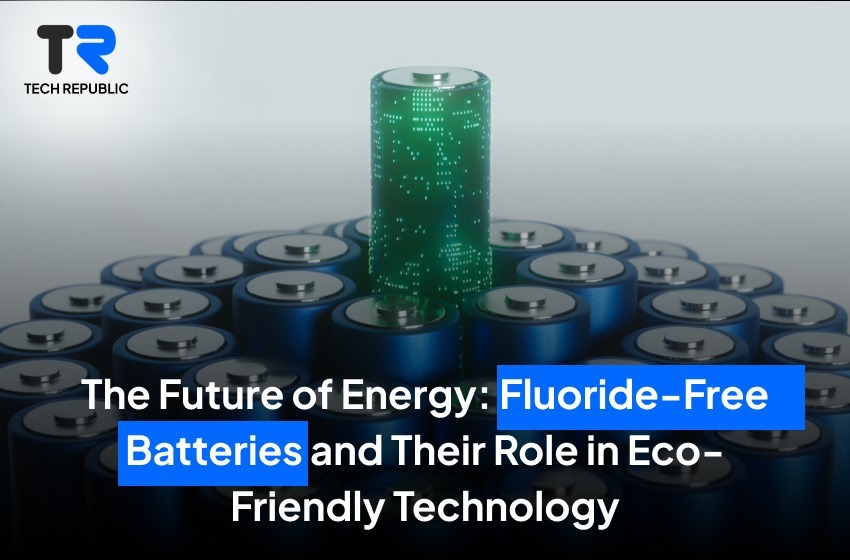
TECH REPUBLIC
PREMIUM PRODUCTS, AFFORDABALE PRICES
PREMIUM PRODUCTS, AFFORDABALE PRICES

As the world moves toward greener energy solutions, the search for sustainable and high-performance battery technologies has become a significant focus. A recent breakthrough in battery technology is the development of fluoride-free batteries, which promises to enhance performance while reducing environmental harm. This innovation could play a pivotal role in advancing renewable energy and minimizing our reliance on harmful chemicals.
The Environmental Challenge of Fluorine in Batteries
Current battery technologies often rely on fluorine-based components, particularly in electrolytes and binders. While these materials help stabilize batteries and enhance their efficiency, they pose serious environmental and health risks. Fluorine compounds can be toxic, corrosive, and difficult to dispose of, contributing to long-term ecological damage.
The demand for eco-friendly solutions has pushed researchers to look for alternatives, and fluoride-free batteries have emerged as a promising option. By eliminating fluorine-based materials, these new batteries aim to reduce the environmental footprint while maintaining—or even improving—performance.
The Science Behind Fluoride-Free Batteries
A team of researchers recently developed a new fluoride-free binder and electrolyte, advancing the eco-friendliness of battery technology without sacrificing functionality. This innovation was published in the Chemical Engineering Journal and represents a significant step toward creating high-performance batteries that are safer for both people and the planet (Tech Xplore).
The fluoride-free electrolytes and binders have been designed to offer greater stability and efficiency than their fluorine-based counterparts. They also improve battery life and performance, which makes them an attractive solution for everything from consumer electronics to electric vehicles (EVs) and renewable energy storage systems.
Why This Matters
Transitioning to fluoride-free batteries could have a broad impact across various sectors, including:
Consumer Electronics: Fluoride-free batteries may lead to safer, more sustainable products, reducing the environmental burden of device disposal.
Electric Vehicles: EVs rely heavily on battery technology. Fluoride-free alternatives could enhance their performance and range, while also contributing to a greener automotive industry.
Renewable Energy: As the world embraces solar and wind energy, effective and sustainable energy storage is crucial. Fluoride-free batteries offer an environmentally responsible way to store renewable energy long-term.
Challenges and the Road Ahead
While the promise of fluoride-free batteries is exciting, the technology is still in its early stages of development. Manufacturing processes, scalability, and cost-efficiency need further refinement before they can compete with traditional battery systems. However, with continued research and support from the energy sector, fluoride-free batteries could play a significant role in shaping the future of energy storage.
Conclusion
The development of fluoride-free batteries marks an exciting advancement in both battery technology and environmental sustainability. By eliminating harmful fluorine-based materials, these batteries offer the potential for safer, more efficient, and eco-friendly energy storage solutions. As the world transitions to greener energy sources, innovations like these are critical to ensuring a sustainable future.
In the coming years, we can expect fluoride-free batteries to play an increasingly prominent role in industries such as renewable energy, electric vehicles, and consumer electronics, helping to reduce the environmental impact of our growing energy needs.






WhatsApp us
Exchange:
You can exchange any product purchased from Techrepublic.pk within 7 days of purchase under the following conditions:
To raise a dispute, please notify us within 7 days of delivery by contacting our support team via email at hello@techrepublic.pk or by calling 0332 272 2666. Each dispute will be evaluated on a case-by-case basis, and we strive to find a fair resolution for both parties.
For damaged items, it is essential to provide an unboxing video as evidence. Please email the video to hello@techrepublic.pk within 7 days of purchase to initiate the replacement process.
Returns:
If a product received does not match the description on our website, you have 7 working days from the date of delivery to claim an exchange the order. To initiate a return, the product(s) must be undamaged, unopened, and returned with all packaging materials and documentation.